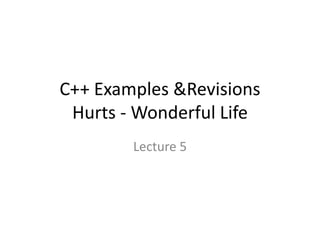
C++ examples &revisions
- 1. C++ Examples &Revisions Hurts - Wonderful Life Lecture 5
- 2. One Dimension Arrays • // arrays example • #include <iostream> • using namespace std; • int billy [] = {16, 2, 77, 40, 12071}; • int n, result=0; • int main () • { • for ( n=0 ; n<5 ; n++ ) • { • result += billy[n]; • } • cout << result; return 0; • } • Output • 12206 •
- 3. Arrays as parameters • #include <iostream> • using namespace std; • void printarray (int arg[], int length) • { • for (int n=0; n<length; n++) • cout << arg[n] << " "; • cout << "n"; • } • int main () { int firstarray[] = {5, 10, 15}; int secondarray[] = {2, 4, 6, 8, 10}; printarray (firstarray,3); printarray (secondarray,5); return 0; }
- 4. Reference operator (&) The address that locates a variable within memory is what we call a reference to that variable. This reference to a variable can be obtained by preceding the identifier of a variable with an ampersand sign (&), known as reference operator, and which can be literally translated as "address of". For example: ted = &andy; This would assign to ted the address of variable andy, since when preceding the name of the variable andy with the reference operator (&) we are no longer talking about the content of the variable itself, but about its reference (i.e., its address in memory). Consider the following code fragment: andy=25 Fred=andy Ted= &andy andy = 25; fred = andy; ted = &andy;
- 5. Cont’d The values contained in each variable after the execution of this, are shown in the following diagram: • The variable that stores the reference to another variable (like ted in the previous example) is what we call a pointer.
- 6. Dereference operator (*) • We have just seen that a variable which stores a reference to another variable is called a pointer. Pointers are said to "point to" the variable whose reference they store. Using a pointer we can directly access the value stored in the variable which it points to. To do this, we simply have to precede the pointer's identifier with an asterisk (*), which acts as dereference operator and that can be literally translated to "value pointed by". Therefore, following with the values of the previous example, if we write:
- 7. Cont’d Beth=*ted • that we could read as: "beth equal to value pointed by ted") beth would take the value 25, since ted is 1776, and the value pointed by 1776 is 25. • Notice the difference between the reference and dereference operators: 1. & is the reference operator and can be read as "address of" 2. * is the dereference operator and can be read as "value pointed by"
- 8. Example#1 • my first pointer • #include <iostream> • using namespace std; • int main () • { • int firstvalue, secondvalue; • int * mypointer; • mypointer = &firstvalue; • *mypointer = 10; • mypointer = &secondvalue; • *mypointer = 20; • cout << "firstvalue is " << firstvalue << endl; • cout << "secondvalue is " << secondvalue << endl; • return 0; • } • The Output • firstvalue is 10 • secondvalue is 20 •
- 9. Example#2 • // more pointers • #include <iostream> • using namespace std; • int main () • { • int numbers[5]; • int * p; • p = numbers; • *p = 10; • p++; • *p = 20; • p = &numbers[2]; • *p = 30; • p = numbers + 3; • *p = 40; • p = numbers; • *(p+4) = 50; • for (int n=0; n<5; n++) • { • cout << numbers[n] << ", "; } • } • return 0; • } • The Output • 10, 20, 30, 40, 50, •
- 10. Arrays • #include <iostream> • using namespace std; • void main() • { • int Nums[4]; • int Sum=0; • cout<<"Enter 4 Numbers :n"; • for(int i=0;i<4;i++) • cin>>Nums[i]; • for(int j=0;j<4;j++) • Sum+=Nums[j]; • cout<<"Sum = "<<Sum<<endl; • }
- 11. Pointer • #include<iostream> • using namespace std; • void Change1(float Data) • { • Data = 9.99; • } • void Change2(float* Data) • { • *Data = 9.99; • } • void main() • { • float F = 3.14; • float* FPtr = &F; • Change1(F); • cout<<"After Change1 : F = "<<F<<endl; • Change2(FPtr); • cout<<"After Change2 : F = "<<F<<endl; • }
